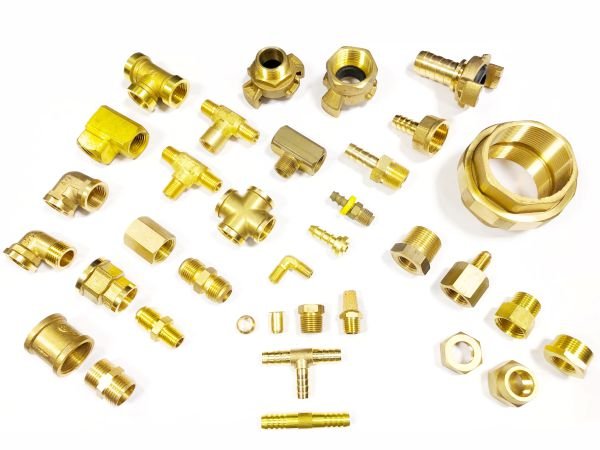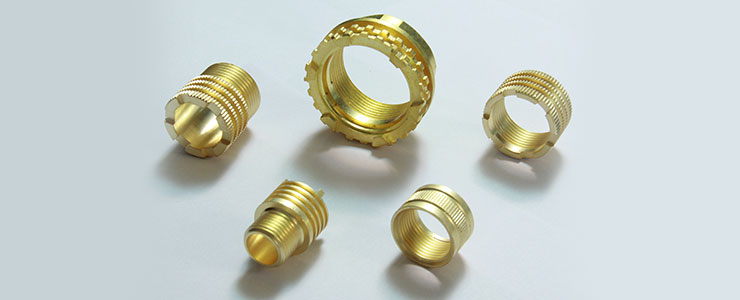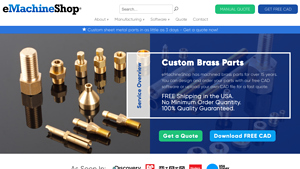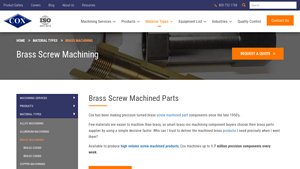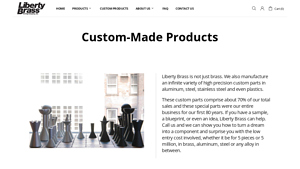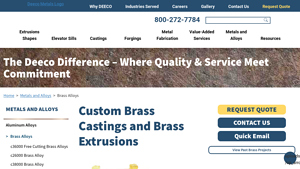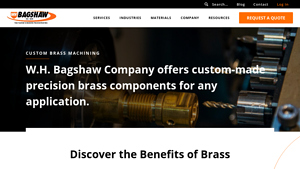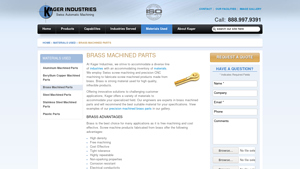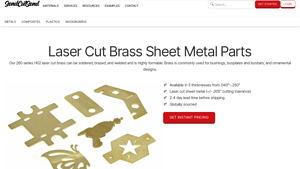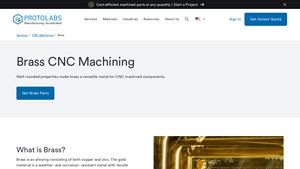Custom Brass Parts Guide: Type, Cost, Top List…
Introduction: Navigating the Global Market for custom brass parts
In today’s competitive landscape, sourcing custom brass parts can present significant challenges for international B2B buyers, particularly those operating in diverse markets across Africa, South America, the Middle East, and Europe. The need for reliable suppliers who can deliver high-quality, precision-engineered components is paramount, as businesses seek to enhance their product offerings while managing costs. This comprehensive guide serves as a vital resource for navigating the complexities of the global market for custom brass parts.
Within these pages, we will explore the various types of brass alloys available, their specific applications, and the machining techniques employed to produce them. Furthermore, we will delve into the essential criteria for vetting suppliers, ensuring that buyers can make informed decisions based on quality, reliability, and cost-effectiveness. By addressing key factors such as lead times, minimum order quantities, and certifications, this guide empowers B2B buyers to streamline their procurement processes and foster successful partnerships.
Whether you are based in Vietnam, Brazil, or any other part of the world, understanding the nuances of custom brass parts manufacturing is crucial for optimizing your supply chain and enhancing your competitive edge. With actionable insights and expert advice, this guide aims to equip you with the knowledge necessary to navigate the global marketplace confidently.
Understanding custom brass parts Types and Variations
| Type Name | Key Distinguishing Features | Primary B2B Applications | Brief Pros & Cons for Buyers |
|---|---|---|---|
| Cartridge Brass | High ductility, excellent for cold working | Plumbing parts, electrical components | Pros: Versatile for complex shapes; Cons: Less corrosion resistant than other alloys. |
| Free Cutting Brass | Superior machinability, often used as a reference | Fluid connectors, threaded inserts | Pros: Cost-effective for high-volume production; Cons: May lack strength in heavy-duty applications. |
| Red Brass | Exceptional corrosion resistance, ideal for marine use | Valves, gears, and weather stripping | Pros: Durable in harsh environments; Cons: Higher cost compared to lower-grade brass. |
| Yellow Brass | Stronger than many brass types, good for soldering | Handrails, grommets, decorative fittings | Pros: Aesthetic appeal; Cons: Harder to machine, requiring skilled labor. |
| Medium-Leaded Brass | Excellent machining and corrosion resistance | Instrument plates, hose fittings | Pros: High precision; Cons: Lead content may limit applications in certain industries. |
What are the Characteristics and Suitability of Cartridge Brass for B2B Buyers?
Cartridge brass, known for its high ductility and cold working capabilities, is a popular choice for various applications such as plumbing parts and electrical components. This alloy can withstand significant deformation without breaking, making it suitable for intricate designs. When purchasing cartridge brass, B2B buyers should consider its lower corrosion resistance compared to other brass types, which may affect its longevity in certain environments.
How Does Free Cutting Brass Benefit High-Volume Production?
Free cutting brass is distinguished by its exceptional machinability, making it a preferred material for applications requiring high-volume production, such as fluid connectors and threaded inserts. Its ease of machining translates to cost savings and faster turnaround times. However, buyers should be cautious of its potential limitations in strength for heavy-duty applications, necessitating a careful assessment of project requirements.
Why Choose Red Brass for Corrosion Resistance?
Red brass is celebrated for its excellent corrosion resistance, particularly in marine environments, making it ideal for components like valves and gears. Its durability ensures longevity, especially in harsh conditions. B2B buyers should weigh the benefits of red brass against its higher cost, as it may impact budget considerations, especially for large-scale projects.
What Makes Yellow Brass Suitable for Decorative Applications?
Yellow brass combines strength with aesthetic appeal, making it a popular choice for decorative fittings, handrails, and grommets. Its soldering capabilities enhance its usability in various applications. However, B2B buyers should be aware that yellow brass can be more challenging to machine, which may require skilled labor and affect production timelines.
How Does Medium-Leaded Brass Offer Precision in Machining?
Medium-leaded brass is known for its excellent machining properties and corrosion resistance, making it suitable for applications like instrument plates and hose fittings. Its high precision is beneficial for industries requiring strict tolerances. Buyers should consider the lead content, as it may restrict the use of medium-leaded brass in specific sectors, such as food and medical applications, necessitating compliance with industry regulations.
Key Industrial Applications of custom brass parts
| Industry/Sector | Specific Application of custom brass parts | Value/Benefit for the Business | Key Sourcing Considerations for this Application |
|---|---|---|---|
| Aerospace | Precision components for aircraft systems | High durability and corrosion resistance | Compliance with aerospace standards, precise tolerances |
| Automotive | Engine components and fittings | Enhanced performance and lower maintenance costs | Material certifications, high-volume production capacity |
| Plumbing | Valves, fittings, and connectors | Leak-proof seals and long-lasting performance | Customization options, quick lead times |
| Electrical & Electronics | Connectors and housings for electronic devices | Improved conductivity and reliability | Electrical standards compliance, bulk purchasing options |
| Medical Devices | Surgical instruments and device housings | Biocompatibility and precision in critical applications | Regulatory compliance, traceability of materials |
How Are Custom Brass Parts Utilized in Aerospace Applications?
In the aerospace industry, custom brass parts are used for precision components essential to aircraft systems, including fittings and connectors. These parts must meet stringent safety and performance standards, ensuring durability under extreme conditions. International buyers need to prioritize suppliers that can provide materials compliant with aerospace regulations and offer precise machining capabilities. The ability to deliver parts with tight tolerances is critical, as even minor discrepancies can lead to safety issues or operational failures.
What Role Do Custom Brass Parts Play in Automotive Manufacturing?
Custom brass components are integral to automotive manufacturing, specifically in engine assemblies and fittings. These parts contribute to improved engine performance and reduced maintenance costs due to their corrosion resistance and durability. Buyers in this sector should consider suppliers that can handle high-volume production and offer reliable delivery schedules. Additionally, sourcing from manufacturers with experience in automotive standards ensures that the components will meet the necessary quality benchmarks.
How Are Custom Brass Parts Essential in Plumbing Systems?
In plumbing applications, custom brass parts such as valves, fittings, and connectors are crucial for creating leak-proof seals and ensuring long-lasting performance. The excellent corrosion resistance of brass makes it ideal for both hot and cold water systems. International buyers should seek suppliers who can provide customized solutions that meet specific plumbing codes and standards. Quick lead times are also essential to minimize project delays, so sourcing from manufacturers with efficient production processes is advisable.
Why Are Custom Brass Parts Preferred in Electrical and Electronics Industries?
Custom brass parts are widely used in the electrical and electronics sectors for connectors and housings due to their excellent conductivity and reliability. These components must adhere to strict electrical standards to ensure safety and performance in various applications. Buyers should focus on sourcing from manufacturers that offer bulk purchasing options and can guarantee compliance with industry regulations. This ensures that the components not only meet technical specifications but also provide value through efficient supply chain management.
How Do Custom Brass Parts Benefit Medical Device Manufacturing?
In the medical device sector, custom brass parts are employed in surgical instruments and device housings, where precision and biocompatibility are paramount. These components must be manufactured to exacting standards to ensure safety and efficacy in medical applications. International buyers should prioritize suppliers who can demonstrate regulatory compliance and provide traceability of materials used in their products. The ability to customize parts for specific medical applications can also significantly enhance operational efficiency and patient outcomes.
3 Common User Pain Points for ‘custom brass parts’ & Their Solutions
Scenario 1: Inconsistent Quality of Custom Brass Parts
The Problem:
B2B buyers often face challenges when sourcing custom brass parts due to inconsistent quality. This inconsistency can arise from a variety of factors, including variations in manufacturing processes, supplier capabilities, and quality control measures. For instance, a buyer might receive a batch of brass components that do not meet specified tolerances, leading to costly rework, production delays, and potential damage to client relationships. These issues are particularly pressing for companies in industries like aerospace or automotive, where precision is critical for safety and functionality.
The Solution:
To mitigate quality issues, it is essential for buyers to establish clear specifications and communicate these thoroughly to suppliers. This includes detailed drawings, tolerance levels, and material requirements. Additionally, conducting supplier audits and requesting samples before placing large orders can help ensure that the manufacturer adheres to quality standards. Implementing a robust quality assurance process—such as in-process inspections and final quality checks—will further enhance confidence in the received parts. Buyers should also consider suppliers who offer a guarantee on their products, which can provide additional assurance of quality and accountability.
Scenario 2: Long Lead Times for Custom Brass Parts
The Problem:
Long lead times are a significant pain point for B2B buyers needing custom brass parts. Delays in production can disrupt supply chains, increase costs, and hinder project timelines, especially in sectors that require rapid prototyping or just-in-time manufacturing. For example, a company may require brass fittings for an urgent project but find that their supplier has extended production times due to high demand or material shortages. This situation can lead to missed deadlines and financial penalties.
The Solution:
To combat long lead times, buyers should prioritize building strong relationships with multiple suppliers to diversify their sourcing options. This strategy allows for quicker turnaround times if one supplier is unable to meet demand. Additionally, utilizing advanced planning tools to forecast needs and place orders well in advance can help mitigate delays. Buyers should also inquire about expedited production options with suppliers and evaluate their capacity to handle rush orders. Lastly, investing in a local supplier can significantly reduce shipping times and enhance responsiveness to urgent needs.
Scenario 3: Difficulty in Achieving Design Specifications
The Problem:
Another common issue for B2B buyers is difficulty in achieving the precise design specifications required for custom brass parts. This challenge often arises when working with complex designs that involve tight tolerances or intricate geometries. When the produced parts do not match the required specifications, it can lead to functional failures in the final product, resulting in costly recalls or repairs. Buyers may feel frustrated when their vision for a component does not align with the capabilities of the manufacturer.
The Solution:
To ensure that design specifications are met, buyers should engage in collaborative design processes with their suppliers. Utilizing tools like 3D CAD models can provide clear visual guidelines and help identify potential manufacturing challenges early in the process. Buyers should also seek manufacturers who offer design assistance or consultation services to refine their designs for manufacturability. Establishing a feedback loop throughout the design and prototyping stages can facilitate adjustments and ensure that the final product meets expectations. Additionally, considering a pilot run before full-scale production can help validate designs and uncover any issues in the early stages.
Strategic Material Selection Guide for custom brass parts
What Are the Key Properties of Common Brass Alloys for Custom Parts?
When selecting materials for custom brass parts, understanding the properties of various brass alloys is essential. Here, we analyze four common brass alloys: Red Brass, Cartridge Brass, Yellow Brass, and Free Cutting Brass. Each has unique characteristics that influence their suitability for specific applications.
What Are the Key Properties of Red Brass?
Red Brass (230 Brass) is known for its excellent corrosion resistance, particularly against seawater, making it ideal for marine applications. It has good machinability and can be easily brazed and enameled. Its low melting point and high malleability allow for intricate designs.
Pros: Red Brass is durable and resistant to corrosion, which extends the lifespan of components. It is also versatile, suitable for various applications like valves and gears.
Cons: While it offers good mechanical properties, it can be more expensive than other brass alloys due to its copper content. Its machining complexity can increase production costs.
Impact on Application: Red Brass is particularly suitable for environments exposed to moisture and corrosive elements. It is commonly used in plumbing and marine hardware.
Considerations for International Buyers: Compliance with standards such as ASTM B584 is critical, especially in regions like Europe and the Middle East, where material specifications are stringent.
How Does Cartridge Brass Perform in Custom Machining?
Cartridge Brass (260 Brass) is favored for its high ductility and excellent cold-working properties. It can withstand severe cold deformations, making it suitable for applications requiring intricate shapes.
Pros: Its high ductility allows for easy forming and machining, making it cost-effective for high-volume production. It is commonly used in the manufacture of ammunition cases and electrical components.
Cons: While it is versatile, Cartridge Brass is less resistant to corrosion compared to Red Brass. This limitation makes it less suitable for marine applications.
Impact on Application: Cartridge Brass is ideal for applications requiring precision and durability, such as in the automotive and electronics industries.
Considerations for International Buyers: Buyers should ensure compliance with standards like ASTM C26000, particularly in regions with strict material regulations, such as Europe.
What Are the Advantages of Yellow Brass for Custom Parts?
Yellow Brass (270 Brass) offers a balance between strength and machinability. It is stronger than Cartridge Brass and has excellent soldering and brazing properties.
Pros: Its strength makes it suitable for applications requiring durable components, such as handrails and decorative items. It also has good corrosion resistance.
Cons: Yellow Brass can be more challenging to machine than softer alloys, potentially increasing manufacturing complexity and costs.
Impact on Application: This alloy is widely used in architectural applications and decorative hardware due to its aesthetic appeal and strength.
Considerations for International Buyers: Compliance with international standards, such as JIS H3250, is essential for ensuring product quality and acceptance in various markets.
Why Choose Free Cutting Brass for High-Volume Production?
Free Cutting Brass (360 Brass) is renowned for its exceptional machinability, making it the go-to choice for high-volume production of precision parts.
Pros: With a machinability rating of 100, it allows for faster production times and lower manufacturing costs. It is ideal for producing components like fluid connectors and threaded inserts.
Cons: While it is easy to machine, Free Cutting Brass may not offer the same level of corrosion resistance as other alloys, limiting its use in certain applications.
Impact on Application: Its ease of machining makes it suitable for industries requiring high precision and rapid production, such as automotive and electronics.
Considerations for International Buyers: Buyers should be aware of potential variations in alloy composition and ensure compliance with local standards, such as ASTM C36000.
Summary Table of Brass Alloys for Custom Parts
| Material | Typical Use Case for custom brass parts | Key Advantage | Key Disadvantage/Limitation | Relative Cost (Low/Med/High) |
|---|---|---|---|---|
| Red Brass | Marine hardware, valves | Excellent corrosion resistance | Higher cost due to copper content | Medium |
| Cartridge Brass | Ammunition cases, electrical components | High ductility and easy forming | Less corrosion resistant | Medium |
| Yellow Brass | Handrails, decorative items | Strong and aesthetically appealing | More difficult to machine | Medium |
| Free Cutting Brass | Fluid connectors, threaded inserts | Exceptional machinability | Limited corrosion resistance | Low |
This guide provides a comprehensive overview of common brass alloys, aiding international B2B buyers in making informed material selections for custom brass parts. Understanding these properties, advantages, and limitations is crucial for optimizing production processes and ensuring compliance with regional standards.
In-depth Look: Manufacturing Processes and Quality Assurance for custom brass parts
What Are the Main Stages of Manufacturing Custom Brass Parts?
The manufacturing of custom brass parts involves several critical stages that ensure both the functionality and quality of the final product. Understanding these stages is essential for B2B buyers looking to source high-quality components.
Material Preparation: What Steps Are Involved?
The first step in the manufacturing process is material preparation. Brass, an alloy primarily composed of copper and zinc, is chosen for its excellent machinability, corrosion resistance, and aesthetic appeal. The material is typically received in bar stock or sheet form and must undergo inspection for quality before being processed. Key activities during this stage include:
- Material Inspection: Ensuring that the brass alloy meets specific standards (e.g., C36000 for free-cutting brass).
- Cutting to Size: Using techniques such as saw cutting or waterjet cutting to prepare the material for subsequent machining processes.
What Techniques Are Used in Forming Custom Brass Parts?
The forming stage is where the actual shaping of the brass occurs. Various machining techniques are employed, depending on the part design and required tolerances:
- CNC Machining: Utilizing computer-controlled machines to mill, turn, or drill the brass into precise shapes. CNC milling is ideal for complex geometries, while CNC turning is used for cylindrical parts.
- Swiss Machining: This method is particularly effective for producing small, intricate components with high precision. It allows for multiple operations to be performed in a single setup, enhancing efficiency.
- EDM (Electrical Discharge Machining): Used for intricate designs, EDM removes material through electrical discharges, allowing for sharp corners and high dimensional accuracy.
How Is Assembly Handled in Custom Brass Manufacturing?
In many cases, custom brass parts require assembly with other components. This can involve processes such as:
- Press Fitting: For joining parts without the need for additional fasteners.
- Soldering or Welding: Depending on the application, different joining techniques may be used to ensure a strong bond between components.
What Finishing Options Are Available for Custom Brass Parts?
Finishing is a crucial stage that enhances both the appearance and functionality of brass parts. Common finishing techniques include:
- Polishing: To achieve a smooth, shiny surface that improves aesthetics.
- Plating: Applying a layer of another metal (e.g., nickel or chrome) for additional corrosion resistance.
- Anodizing: Although more common with aluminum, some brass components can be anodized for enhanced surface durability.
What Quality Assurance Processes Should B2B Buyers Expect?
Quality assurance (QA) is vital in the manufacturing of custom brass parts, ensuring that products meet international standards and customer specifications.
Which International Standards Are Relevant for Brass Part Manufacturing?
B2B buyers should look for suppliers that comply with recognized international standards, such as:
- ISO 9001: This standard focuses on quality management systems and ensures that manufacturers maintain consistent quality throughout the production process.
- CE Marking: Common in Europe, this indicates compliance with health, safety, and environmental protection standards.
- API Standards: Relevant for brass components used in the oil and gas industry, ensuring reliability and safety.
What Are the Key Quality Control Checkpoints in Brass Manufacturing?
Quality control is typically divided into several checkpoints throughout the manufacturing process:
- Incoming Quality Control (IQC): Inspecting raw materials upon arrival to verify compliance with specifications.
- In-Process Quality Control (IPQC): Ongoing inspections during the manufacturing process to catch defects early.
- Final Quality Control (FQC): A comprehensive inspection of the finished product before shipping, ensuring it meets all design specifications and quality standards.
How Can B2B Buyers Verify Supplier Quality Control Practices?
To ensure that suppliers maintain high-quality standards, B2B buyers should consider the following verification methods:
- Supplier Audits: Conducting regular audits of suppliers to assess their manufacturing processes and quality control systems.
- Quality Reports: Requesting documentation that outlines testing results, compliance with standards, and any certifications held by the supplier.
- Third-Party Inspections: Engaging independent inspection agencies to conduct assessments and provide unbiased evaluations of product quality.
What Testing Methods Are Commonly Used in Quality Assurance for Brass Parts?
Several testing methods are employed to verify the quality and performance of custom brass parts:
- Dimensional Inspection: Using precision measuring instruments to ensure that parts meet specified tolerances.
- Material Testing: Analyzing the chemical composition and physical properties of the brass to confirm it meets required standards.
- Functional Testing: Simulating real-world conditions to ensure parts perform as intended, particularly for components used in critical applications.
How Do Quality Control Nuances Affect International B2B Buyers?
B2B buyers from regions such as Africa, South America, the Middle East, and Europe must be aware of specific nuances related to quality control in international sourcing:
- Cultural Differences in Quality Expectations: Understanding that quality standards may vary significantly across regions. Buyers should communicate their expectations clearly to avoid misunderstandings.
- Regulatory Compliance: Ensuring that products meet local regulations and standards, which may differ from those in the supplier’s country.
- Logistical Considerations: Factor in potential delays in shipping and customs that could impact the timely delivery of high-quality components.
By comprehensively understanding the manufacturing processes and quality assurance practices involved in sourcing custom brass parts, B2B buyers can make informed decisions that ensure they receive high-quality products tailored to their specific needs.
Practical Sourcing Guide: A Step-by-Step Checklist for ‘custom brass parts’
Introduction
Sourcing custom brass parts can be a complex process, particularly for B2B buyers who need to ensure quality, compatibility, and cost-effectiveness. This guide provides a step-by-step checklist to streamline your procurement process, ensuring you make informed decisions while minimizing risks. Whether you’re in Africa, South America, the Middle East, or Europe, these actionable steps will help you navigate the sourcing landscape effectively.
Step 1: Define Your Technical Specifications
Clearly outlining your technical requirements is the foundation of a successful procurement process. This includes dimensions, tolerances, material grades, and any specific finishing options. Having precise specifications helps suppliers understand your needs and reduces the likelihood of errors in production.
- Considerations:
- Are there industry standards you must adhere to?
- Do you need specific brass alloys for corrosion resistance or aesthetic appeal?
Step 2: Research Potential Suppliers
Conduct thorough research to identify potential suppliers who specialize in custom brass parts. Look for companies with a proven track record, robust manufacturing capabilities, and positive customer reviews. This step ensures that you engage with suppliers who can meet your quality and delivery expectations.
- Where to Look:
- Online directories and industry forums.
- Trade shows and exhibitions in your region.
Step 3: Evaluate Supplier Capabilities
Before committing to a supplier, assess their manufacturing capabilities. This includes their machinery, production processes, and the range of brass alloys they can work with. Understanding their capabilities will help you determine if they can meet your specific needs.
- Key Questions:
- What machining processes do they offer (CNC, EDM, etc.)?
- Can they handle both low and high-volume orders?
Step 4: Request Samples and Prototypes
Always request samples or prototypes before placing a large order. This step allows you to evaluate the quality of the brass parts and ensure they meet your specifications. It’s an opportunity to identify any potential issues early in the process.
- What to Assess:
- Material quality and finish.
- Dimensional accuracy and tolerances.
Step 5: Verify Certifications and Compliance
Ensure that the suppliers you are considering hold the necessary certifications and comply with relevant industry standards. Certifications such as ISO 9001 can indicate a commitment to quality management. Compliance with local and international standards is crucial for reliability and safety.
- Checklist:
- Ask for documentation of certifications.
- Verify compliance with environmental and safety regulations.
Step 6: Negotiate Terms and Conditions
Once you’ve selected a supplier, negotiate terms that are favorable for both parties. This includes pricing, payment terms, lead times, and delivery conditions. Clear agreements help prevent misunderstandings and foster a positive working relationship.
- Important Points:
- Discuss penalties for late deliveries.
- Clarify responsibilities for shipping and handling.
Step 7: Establish a Communication Plan
Effective communication is key to successful sourcing. Set up a communication plan that outlines how and when you will communicate with your supplier. Regular updates can help track production progress and address any issues promptly.
- Considerations:
- Preferred methods of communication (email, phone, etc.).
- Frequency of updates and meetings.
By following this checklist, B2B buyers can effectively navigate the complexities of sourcing custom brass parts, ensuring high-quality outcomes that meet their specific needs.
Comprehensive Cost and Pricing Analysis for custom brass parts Sourcing
What Are the Key Cost Components in Custom Brass Parts Sourcing?
When sourcing custom brass parts, understanding the cost structure is essential for making informed purchasing decisions. The primary cost components include:
-
Materials: The choice of brass alloy significantly impacts costs. Common alloys like C36000 (Free Cutting Brass) are generally more economical due to their machinability, while specialized alloys like C23000 (Red Brass) may incur higher costs due to their unique properties.
-
Labor: Labor costs vary by region and depend on the complexity of the machining processes involved. Skilled labor is often required for intricate designs, which can increase overall expenses.
-
Manufacturing Overhead: This includes the costs associated with running machinery, utilities, and facility maintenance. Efficient operations can help minimize these costs, benefiting the buyer.
-
Tooling: Custom tooling may be necessary for specific designs. The initial investment in tooling can be significant, but it often leads to lower per-unit costs in high-volume runs.
-
Quality Control (QC): Ensuring the parts meet industry standards requires rigorous QC processes. This adds to the overall cost but is crucial for avoiding defects and ensuring compliance with regulations.
-
Logistics: Shipping costs, particularly for international transactions, can vary widely based on distance, weight, and chosen shipping methods. Incoterms also play a critical role in determining who bears these costs.
-
Margin: Suppliers typically add a margin to cover their operational costs and profit. Understanding the market landscape can help buyers gauge whether the pricing is competitive.
How Do Volume and Customization Influence Pricing for Brass Parts?
Pricing for custom brass parts is heavily influenced by order volume and the level of customization required.
-
Volume/MOQ: Many suppliers offer tiered pricing, where the cost per unit decreases as order quantities increase. This is particularly important for businesses looking to scale production without incurring excessive costs.
-
Specifications and Customization: Highly customized parts often come at a premium. Buyers should evaluate whether the specific features are essential, as simplifying designs can lead to cost savings.
What Are the Quality and Certification Considerations That Affect Brass Parts Pricing?
Quality assurance and certifications can significantly impact pricing. Suppliers that offer certified products (e.g., ISO standards) often charge more due to the associated quality control processes. Buyers should consider:
-
Material Quality: Higher-quality brass alloys may be more expensive but can offer better performance and longevity, reducing the total cost of ownership.
-
Certifications: Products that meet specific industry standards can command higher prices, reflecting their reliability and safety.
How Can Buyers Negotiate Better Prices for Custom Brass Parts?
Effective negotiation strategies can help buyers secure better pricing. Here are some tips:
-
Leverage Volume Discounts: Buyers should communicate their expected order volumes to suppliers to negotiate better rates based on bulk purchasing.
-
Be Transparent About Specifications: Providing clear specifications and requirements can help suppliers prepare accurate quotes, reducing back-and-forth negotiations.
-
Explore Multiple Suppliers: Gathering quotes from several suppliers can create competitive pressure, potentially lowering costs.
What Are the Pricing Nuances for International B2B Buyers in Regions Like Africa and South America?
International buyers must be aware of specific pricing nuances:
-
Currency Fluctuations: Exchange rate volatility can impact costs, making it essential for buyers to consider pricing in their local currency.
-
Import Tariffs and Duties: These can add significant costs to imported brass parts. Understanding local regulations can help buyers anticipate additional expenses.
-
Logistics Challenges: Shipping times and costs can vary greatly. Opting for suppliers with established logistics networks may mitigate delays and unexpected costs.
Conclusion
Navigating the cost structure and pricing factors for custom brass parts requires careful consideration of various elements. By understanding the key cost components, negotiating effectively, and being aware of international nuances, buyers can optimize their sourcing strategies. It’s important to note that prices can vary widely based on many factors, and obtaining quotes from multiple suppliers is advisable for the best outcomes.
Alternatives Analysis: Comparing custom brass parts With Other Solutions
Exploring Alternatives for Custom Brass Parts in B2B Applications
In the world of manufacturing, selecting the right material and method is crucial for optimizing performance and cost-efficiency. Custom brass parts are a popular choice due to their unique properties, but there are alternative solutions that may suit specific needs better. This analysis compares custom brass parts with other viable alternatives, enabling B2B buyers to make informed decisions based on their operational requirements.
| Comparison Aspect | Custom Brass Parts | Aluminum Components | Plastic Parts |
|---|---|---|---|
| Performance | High corrosion resistance, durable | Lightweight, good thermal conductivity | Lightweight, versatile |
| Cost | Moderate to high | Generally lower | Lowest cost |
| Ease of Implementation | Requires specialized machining | Easier to machine, less specialized | Simple fabrication processes |
| Maintenance | Low maintenance, but can corrode if not treated | Low maintenance, does not corrode | Low maintenance, but can degrade under UV |
| Best Use Case | Applications requiring durability and aesthetics | Aerospace, automotive, and construction | Consumer products, packaging, and low-stress applications |
What Are the Pros and Cons of Aluminum Components?
Aluminum components present a lightweight alternative to custom brass parts. They are often more cost-effective and easier to machine, allowing for quicker production times. Aluminum’s excellent thermal conductivity makes it a preferred choice in applications such as aerospace and automotive industries. However, while aluminum has a good strength-to-weight ratio, it lacks the same level of corrosion resistance as brass, which may be critical in certain environments, particularly in marine or chemical applications.
How Do Plastic Parts Compare?
Plastic parts are the most economical choice among alternatives, offering significant flexibility in design and application. They can be molded into complex shapes and are commonly used in consumer products and packaging. The ease of fabrication reduces lead times, making plastics attractive for high-volume production. However, plastics may not withstand high temperatures or heavy loads, and certain types can degrade when exposed to UV light or harsh chemicals, which limits their use in demanding applications.
Conclusion: How Should B2B Buyers Choose the Right Solution?
When considering custom brass parts versus alternatives like aluminum or plastic, B2B buyers should evaluate the specific requirements of their applications. Factors such as performance needs, budget constraints, and the environmental conditions of use will influence the decision. For applications requiring durability and aesthetic appeal, custom brass parts are often the best choice. Conversely, for lightweight and cost-sensitive projects, aluminum or plastic may be more suitable. Ultimately, understanding the strengths and limitations of each option will guide buyers in selecting the ideal solution for their manufacturing needs.
Essential Technical Properties and Trade Terminology for custom brass parts
What Are the Key Technical Properties of Custom Brass Parts?
When sourcing custom brass parts, understanding their technical properties is crucial for making informed purchasing decisions. Here are some key specifications that every B2B buyer should know:
1. Material Grade
Material grade refers to the specific type of brass alloy used in the manufacturing process. Common grades include C26000 (Cartridge Brass) and C36000 (Free Cutting Brass). Each grade has unique characteristics, such as corrosion resistance and machinability, which directly affect the performance of the final product. Selecting the right grade ensures that the parts meet the specific requirements of their application, minimizing the risk of failure and enhancing product longevity.
2. Tolerance
Tolerance indicates the permissible limit of variation in a part’s dimensions. In brass machining, tight tolerances are essential for ensuring that components fit together correctly and function as intended. For example, a tolerance of ±0.01 mm might be critical in applications like plumbing fittings or electronic connectors. Understanding tolerance specifications helps buyers communicate their needs effectively to manufacturers, thereby reducing the likelihood of costly errors.
3. Surface Finish
The surface finish refers to the texture and smoothness of the finished part. Options range from polished to rough, affecting not only aesthetics but also functionality, such as corrosion resistance and ease of assembly. A well-defined surface finish can enhance the durability of a component and improve its performance in specific environments, making it a vital consideration in the design phase.
4. Machinability Rating
Machinability rating measures how easily a material can be machined into precise shapes. Brass typically has high machinability, which is quantified on a scale of 0 to 100, with C36000 brass rated at 100. High machinability means lower production costs and faster lead times, which are crucial for businesses needing to maintain competitive pricing and quick turnaround.
5. Corrosion Resistance
Corrosion resistance is the ability of brass to withstand degradation due to environmental factors. This property is especially important for parts used in outdoor or marine applications. Buyers must consider the operating environment when selecting brass alloys, as some grades, like Red Brass (C23000), offer superior corrosion resistance compared to others.
What Are Common Trade Terms Related to Custom Brass Parts?
Understanding industry jargon can streamline communications and negotiations between buyers and suppliers. Here are some key terms to be familiar with:
1. OEM (Original Equipment Manufacturer)
OEM refers to companies that produce parts or equipment that may be marketed by another manufacturer. In the brass parts industry, an OEM might design components that are then manufactured by a specialized brass machining company. Knowing about OEM relationships can help buyers identify potential suppliers that have the capability to meet specific design and quality standards.
2. MOQ (Minimum Order Quantity)
MOQ is the smallest number of units that a supplier is willing to produce or sell. Understanding MOQ is essential for budget planning and inventory management. For instance, a supplier might set an MOQ of 100 parts for custom brass fittings, which could affect the buyer’s decision if they only need 50.
3. RFQ (Request for Quotation)
An RFQ is a document sent by a buyer to potential suppliers to solicit price quotes for specific products or services. It typically includes details such as material specifications, quantities, and delivery timelines. Properly crafting an RFQ can lead to better pricing and terms, as suppliers can provide more accurate quotes based on clear requirements.
4. Incoterms (International Commercial Terms)
Incoterms are a set of international rules that define the responsibilities of sellers and buyers in terms of shipping, risk, and insurance. Familiarity with Incoterms is crucial for international transactions, as it clarifies who is responsible for costs and risks at various stages of shipping. Common terms include FOB (Free on Board) and CIF (Cost, Insurance, and Freight).
By grasping these technical properties and trade terms, B2B buyers can navigate the complexities of sourcing custom brass parts more effectively, ensuring that they select the right components for their specific applications.
Navigating Market Dynamics and Sourcing Trends in the custom brass parts Sector
What Are the Key Market Dynamics and Trends in the Custom Brass Parts Sector?
The custom brass parts market is currently experiencing robust growth, driven by several global factors. The rise in demand for brass components across various industries, including automotive, aerospace, plumbing, and electronics, has highlighted brass’s unique properties, such as corrosion resistance and machinability. Emerging markets in Africa, South America, the Middle East, and Europe are increasingly seeking reliable suppliers who can meet their specific needs, often requiring customization and fast turnaround times.
Recent technological advancements in manufacturing processes, such as CNC machining and waterjet cutting, are revolutionizing the production of brass components, allowing for greater precision and efficiency. The introduction of digital tools, including CAD software for design and real-time quoting systems, is enhancing the buyer-supplier relationship, enabling international buyers to engage in a more streamlined procurement process. Additionally, the trend towards automation and smart manufacturing is shaping the landscape, as companies look to optimize production capabilities while reducing costs.
International B2B buyers are advised to closely monitor these market dynamics to leverage opportunities for cost savings and efficiency. Establishing relationships with manufacturers who can adapt to the evolving landscape and provide innovative solutions will be crucial for maintaining competitiveness in the global marketplace.
How Does Sustainability and Ethical Sourcing Impact the Custom Brass Parts Sector?
Sustainability has become a pivotal concern in the sourcing of custom brass parts. The environmental impact of brass production, particularly in terms of mining and processing copper and zinc, has led to an increasing emphasis on responsible sourcing practices. B2B buyers are now prioritizing suppliers who demonstrate a commitment to ethical supply chains, including transparency in sourcing materials and adherence to environmental regulations.
The importance of certifications such as ISO 14001, which focuses on effective environmental management systems, is growing. Buyers should seek suppliers who can provide documentation of their sustainability practices and material certifications. This not only ensures compliance with international standards but also enhances brand reputation among environmentally conscious consumers.
Moreover, the adoption of recycled brass and other sustainable materials is gaining traction. Using recycled materials can significantly reduce the carbon footprint associated with brass manufacturing. Buyers are encouraged to inquire about the availability of ‘green’ brass options and other eco-friendly practices that suppliers may employ to minimize environmental impact.
How Has the Custom Brass Parts Industry Evolved Over Time?
The custom brass parts industry has evolved significantly over the past century, transitioning from traditional handcrafting techniques to advanced machining processes. Initially, brass components were predominantly produced through manual methods, which limited production scalability and consistency. The introduction of automated machining technologies in the mid-20th century marked a turning point, enabling mass production with higher precision and lower costs.
Today, the industry leverages sophisticated techniques such as CNC machining, EDM, and multi-spindle turning, which allow for intricate designs and tighter tolerances. This evolution has not only increased efficiency but has also expanded the applications of brass in various sectors, from intricate electronic components to robust plumbing fixtures. As technology continues to advance, the custom brass parts sector is poised for further innovation, catering to the increasing demands of global markets.
In conclusion, understanding these market dynamics, sustainability considerations, and the historical context of the custom brass parts industry will empower international B2B buyers to make informed sourcing decisions and foster long-lasting supplier relationships.
Frequently Asked Questions (FAQs) for B2B Buyers of custom brass parts
-
1. How do I choose the right supplier for custom brass parts?
Selecting the right supplier involves evaluating several key factors. Look for manufacturers with a solid track record in brass machining and positive customer reviews. Assess their production capabilities, including technology and equipment used, to ensure they can meet your specifications. Additionally, verify their quality assurance processes and certifications. Establish clear communication regarding lead times, pricing, and support to ensure a collaborative relationship. Finally, consider suppliers that understand international shipping regulations to facilitate smooth cross-border transactions. -
2. What are the common applications for custom brass parts?
Custom brass parts are widely used across various industries due to their excellent mechanical properties and corrosion resistance. Common applications include plumbing fittings, electrical connectors, automotive components, and decorative hardware. Brass is also favored in the manufacturing of gears, valves, and fasteners due to its low friction coefficient and ability to withstand high temperatures. For specialized applications, custom designs can be created to meet specific requirements, enhancing functionality and efficiency. -
3. What is the minimum order quantity (MOQ) for custom brass parts?
Minimum order quantities can vary significantly between suppliers, often ranging from small batches of 10-50 pieces to larger orders in the thousands. Many manufacturers offer flexibility, allowing for low MOQ for initial prototypes or small production runs, especially for new buyers. It’s advisable to communicate your needs upfront to negotiate the best terms. Additionally, consider how the MOQ aligns with your production schedule and inventory management strategies. -
4. How can I ensure quality control for custom brass parts?
Quality control starts with choosing a reputable supplier who implements stringent quality assurance measures. Request documentation of their quality certifications, such as ISO 9001. During production, consider arranging for inspections at various stages, including material verification and final product checks. Utilizing third-party inspection services can also provide an unbiased assessment of compliance with specifications. Establish clear quality standards and expectations in your contract to safeguard against defects. -
5. What payment terms should I expect when sourcing custom brass parts?
Payment terms can vary by supplier but typically include options such as upfront deposits, net 30, or net 60 terms. International transactions may require letters of credit or escrow services to mitigate risk. It’s crucial to discuss payment schedules and methods during negotiations to ensure clarity and agreement. Ensure that the payment terms align with your cash flow capabilities and factor in potential tariffs and shipping costs when budgeting. -
6. How does international shipping work for custom brass parts?
Shipping custom brass parts internationally involves several steps, including selecting a reliable freight forwarder experienced in handling industrial goods. Assess shipping options, such as air freight for faster delivery or sea freight for cost-effectiveness. Be aware of import regulations, tariffs, and taxes in your country to avoid unexpected costs. Additionally, ensure that the supplier provides necessary documentation, including invoices, packing lists, and certificates of origin, to facilitate customs clearance. -
7. Can I get custom brass parts designed to my specifications?
Yes, many suppliers offer custom design services to create brass parts tailored to your specific needs. You can provide a detailed drawing, 3D model, or even a sample of the part you need. Collaborating with the supplier’s engineering team can help optimize the design for manufacturability and cost-effectiveness. Make sure to discuss materials, finishes, and tolerances to ensure the final product meets your functional and aesthetic requirements. -
8. What are the advantages of using brass over other materials for custom parts?
Brass offers several advantages compared to other materials like aluminum or stainless steel. It has a high machinability rating, making it easier to produce complex shapes and designs. Brass also exhibits excellent corrosion resistance, particularly in marine environments, and has a low friction coefficient, which is ideal for moving parts. Additionally, its aesthetic appeal and ability to be finished in various ways make it a popular choice for decorative applications.
Important Disclaimer & Terms of Use
⚠️ Important Disclaimer
The information provided in this guide, including content regarding manufacturers, technical specifications, and market analysis, is for informational and educational purposes only. It does not constitute professional procurement advice, financial advice, or legal advice.
While we have made every effort to ensure the accuracy and timeliness of the information, we are not responsible for any errors, omissions, or outdated information. Market conditions, company details, and technical standards are subject to change.
B2B buyers must conduct their own independent and thorough due diligence before making any purchasing decisions. This includes contacting suppliers directly, verifying certifications, requesting samples, and seeking professional consultation. The risk of relying on any information in this guide is borne solely by the reader.
Top 8 Custom Brass Parts Manufacturers & Suppliers List
1. eMachineShop – Custom Brass Parts
Domain: emachineshop.com
Registered: 1999 (26 years)
Introduction: eMachineShop offers custom brass parts with over 15 years of experience in brass fabrication. Key features include:
– Free CAD software for design and ordering or the option to upload CAD files for fast quotes.
– Free shipping within the USA.
– No minimum order quantity.
– 100% quality guarantee.
Brass is a metal alloy made from copper and zinc, known for its attractive gold appearance, non-magne…
2. Cox Manufacturing – Precision Turned Brass Screw Machined Parts
Domain: coxmanufacturing.com
Registered: 2003 (22 years)
Introduction: Cox Manufacturing specializes in precision turned brass screw machined parts. They have been producing these components since the late 1950s and can manufacture up to 1.7 million precision components weekly. Key advantages of brass screw machined parts include durability, cost efficiency, high heat and corrosion resistance, and ease of machining and joining. Common applications for brass CNC machi…
3. Liberty Brass – Custom Precision Parts
Domain: libertybrass.com
Registered: 1996 (29 years)
Introduction: Custom Made Products by Liberty Brass include high precision custom parts made from brass, aluminum, steel, stainless steel, and plastics. These custom parts account for about 70% of total sales. Liberty Brass can manufacture from 5 pieces to 5 million, based on samples, blueprints, or ideas provided by customers. The company emphasizes low entry costs for custom manufacturing.
4. DeeCom Metals – Custom Brass Castings & Extrusions
Domain: deecometals.com
Registered: 2001 (24 years)
Introduction: Custom Brass Castings & Extrusions, including Cast Brass Parts, Architectural Metal Extrusions, Elevator Sills, and various types of brass alloys such as Aluminum Brass, Nickel Silver, Corrosion-Resistant Brass, Dezincification-Resistant Brass, Lead-Free Brass Alloys, High Tensile Brasses, Architectural Brass/Bronze Alloys, Cold Forming Brass Alloys, Free Cutting & Machining Brass Alloys, Hot Forg…
5. W.H. Bagshaw – Custom Precision Brass Components
Domain: whbagshaw.com
Registered: 1997 (28 years)
Introduction: W.H. Bagshaw Company offers custom-made precision brass components for various applications. Brass is a copper and zinc alloy known for its dark-gold color, low friction, good corrosion resistance, high malleability, non-ferromagnetic properties, excellent heat and electrical conductivity, and superior machinability. Common grades of brass include Free Machining Brass (C36000) and Naval Brass (C46…
6. Kagerind – Custom Brass Swiss Machined Parts
Domain: kagerind.com
Registered: 1999 (26 years)
Introduction: Brass Swiss Machined Parts – Custom Brass CNC Machining. Key Features: High density, Free machining, Cost effective, Tight tolerance, Highly repeatable, Non-sparking properties, Corrosion resistant, Electrical conductivity. Brass Alloys Offered: C360, C353, C464. Industries Served: Fishing, Archery, Medical, Connector, Automotive, Hobby & Toys. Manufacturing Techniques: Swiss screw machining, Prec…
7. SendCutSend – Brass Sheet Metal Laser Cutting
Domain: sendcutsend.com
Registered: 2015 (10 years)
Introduction: Brass Sheet Metal Laser Cutting
– Material: C260 Brass
– Thickness Options: .040″ (1.02mm), .063″ (1.60mm), .125″ (3.18mm), .187″ (4.75mm), .250″ (6.35mm)
– Min/Max Part Sizes: Min: .25″ x .375″, Max: 30″ x 44″
– Cutting Tolerance: +/- .005″
– Lead Time: 2-4 days before shipping
– Formability: Highly formable, can be soldered, brazed, and welded
– Common Uses: Bushings, busplates, busbars, ornamen…
8. Protolabs – CNC Machining Services for Brass Components
Domain: protolabs.com
Registered: 2006 (19 years)
Introduction: Protolabs offers CNC machining services for brass components, providing precision manufacturing for various applications. The service includes rapid prototyping and low-volume production, with capabilities to produce complex geometries and tight tolerances. Protolabs utilizes advanced CNC machining technology to ensure high-quality finishes and quick turnaround times. The brass materials available…
Strategic Sourcing Conclusion and Outlook for custom brass parts
How Can Strategic Sourcing Enhance Your Procurement of Custom Brass Parts?
In the dynamic landscape of manufacturing, strategic sourcing of custom brass parts is crucial for international B2B buyers. The versatility of brass, coupled with its favorable machining properties, positions it as a preferred material across various applications, from plumbing to electronics. By leveraging insights from experienced suppliers, businesses can optimize their procurement processes, ensuring cost-effectiveness and quality assurance.
Investing in a reliable supply chain allows for flexibility in order quantities and facilitates quicker turnaround times. Buyers should prioritize partnerships with manufacturers that offer advanced machining techniques, such as CNC milling and Swiss machining, to achieve precision and efficiency in production. Understanding the specific properties of different brass alloys enables tailored solutions that meet unique project requirements.
Looking ahead, the global demand for custom brass parts is expected to rise, driven by innovations in technology and manufacturing. International buyers, especially from regions like Africa, South America, the Middle East, and Europe, should seize this opportunity to enhance their sourcing strategies. By aligning with trusted suppliers, businesses can not only secure high-quality components but also position themselves for sustainable growth in a competitive market. Engage with industry leaders today to explore how strategic sourcing can transform your operations.
